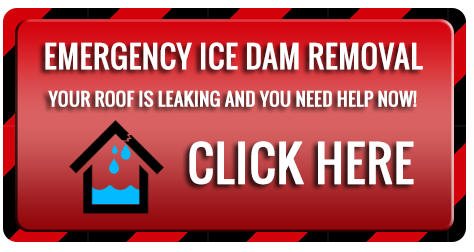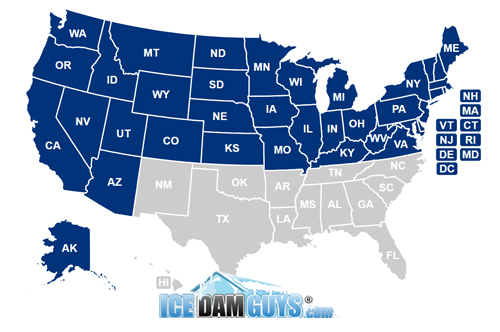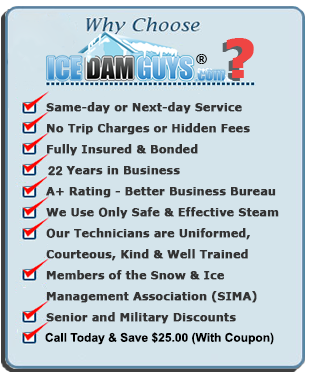When Should I Remove Snow from My Roof?
Call us at 1-800-423-3267 if you have an ice dam on your roof and live anywhere in the US, including in hard-hit Alaska. We are properly licensed, bonded, and insured, and are the top-rated ice dam removal company in the US. You can end the leaks with a phone call to Ice Dam Guys®.
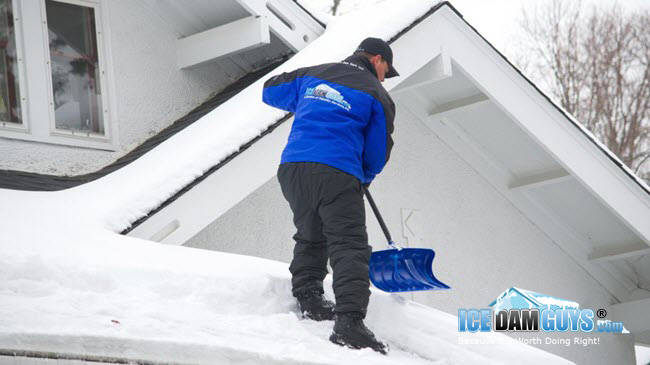
Removing snow from your roof is a pain. You probably don’t want to do it unless you absolutely must.
When must you remove the snow from your roof – either shovel or rake it off yourself, or call a snow removal professional? There’s no single rule of thumb, but rather a few factors to consider.
Why worry about roof snow in the first place?
There are only two reasons you’d worry about removing snow from your roof. What you should do about the roof snow depends on which problem concerns you.
The first reason to worry about roof snow is you’re worried about a roof collapse.
The second reason is you live in an ice-dam prone home and you want to prevent ice dams.
That’s it. If it weren’t for those two concerns, you could just let the snow pile onto your roof.
To prevent a roof collapse, the slope of your roof makes a huge difference.
The first question to ask yourself when determining whether to get out there and start removing that roof snow is: “What’s the pitch of my roof?”
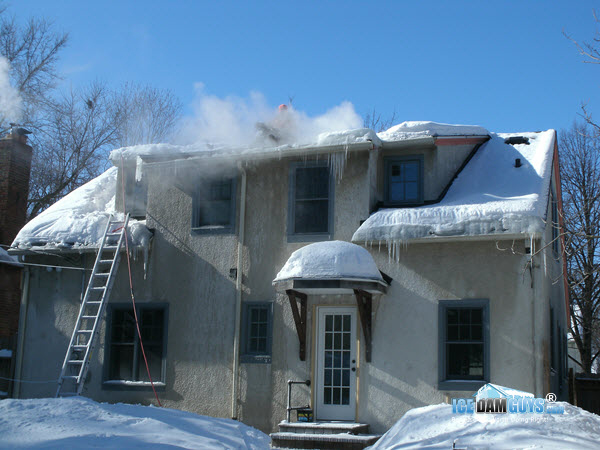
A flat roof is often times more susceptible to collapse than a sloped roof, simply because a sloped roof disperses weight whereas a flat roof cannot. Generally, the steeper your roof angle the more snow it can hold (e.g. a 10/12 or 12/12 pitch roof handles more snow than a flat roof). In addition, steeper roofs don’t often collect as much snow in the first place. Snow tends to slide right off of a pitched roof. When it doesn’t slide off it can get blown away by the wind. That doesn’t mean you’ll never get snow on your pitched roof -you will – but a flat roof or extremely shallow-pitched roof will almost always collect more snow.
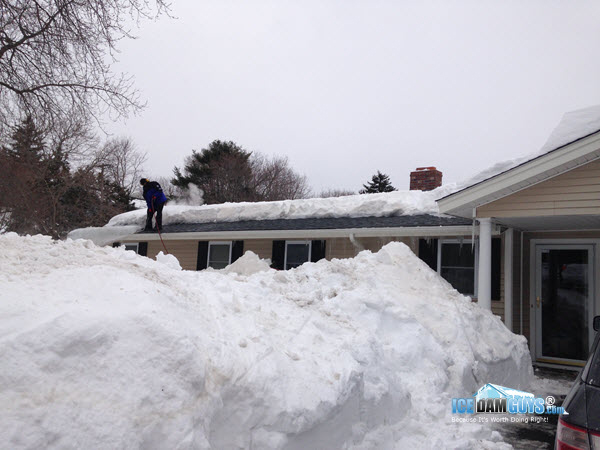
If your roof is steeply pitched and a roof collapse is your main concern, you might be able to get away with waiting to remove the snow until you’ve got a good couple feet of snow up there. In many cases a pitched roof can handle even more snow than that, unless of course there is a major design flaw in the house, or you’ve got a really old house. In either of those cases, you might want to remove the snow even when there’s only a foot or so up there.
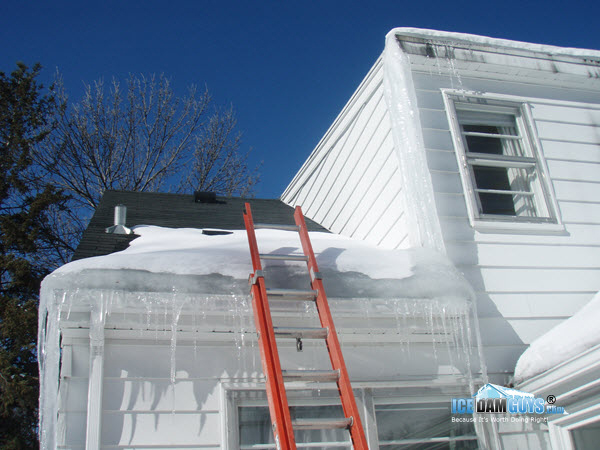
Also, where geographically in the US it snows has changed in the past 50-or-so years. Depending on where your home is located, it may not have been designed for the amount of snow your part of the country now receives.
Flat roofs are often far more dangerous than pitched roofs.
When you hear about a roof collapse on the news, 9 times out of 10 you’ll see a picture of a flat roof. It’s usually commercial buildings, because most commercial buildings have flat roofs.
That’s because the snow never really leaves a flat roof. The roof holds almost all of it. Even if it gets wind-blown, it just blows to some other section of the roof. It may be one foot high in one spot and eight feet high in another spot. You need to be careful with flat roofs. It doesn’t take much snow piled up into one concentrated area to collapse a flat roof. You might want to get out there, or have someone else get out there, if you see 1-2 feet of snow anywhere on the roof. If you’ve got 1-2 feet of snow on your roof (visible from the ground), there’s a chance you’ve got some epic snowdrifts hiding somewhere not visible from the ground.
With a flat roof you also have to look at the snow total for the year, not just how much snow appears to be on the roof at any given moment. Often with a flat roof you’ve got a drainage system that’s frozen. You might look up and say, “Well, there’s only ten inches of snow up there.” But if you had 80 inches of snow this season, there’s a chance all 80 inches simply melted or compressed down to 10 inches of heavy, super-saturated wet snow. An inch of snow is not always an inch of snow.
Snow doesn’t change its weight when it melts. It simply changes its form. If you don’t see water coming out of the end of the scuppers, then you need someone to clear up your drainage system. (As an ice dam company, we frequently get called out to steam frozen drains and scuppers.)
Some homeowners have flat roofs, too – often above a porch or an addition. Be a little extra paranoid if you’ve got one of those, because that porch roof can collapse. It’s also worth noting that residential-grade flat roofs typically are not built to be nearly as sturdy as are commercial-grade flat roofs.
A shallow-pitch roof is almost as bad as a flat roof.
A shallow pitch can be trouble, too. It’s not just “flat roof” vs. “pitched roof.” Roof pitch is a sliding scale. A roof at a 4/12 pitch, for example, is almost flat. If you’ve got one, it would be a good idea to remove the snow a little sooner than you would if you had a 10/12 pitch.
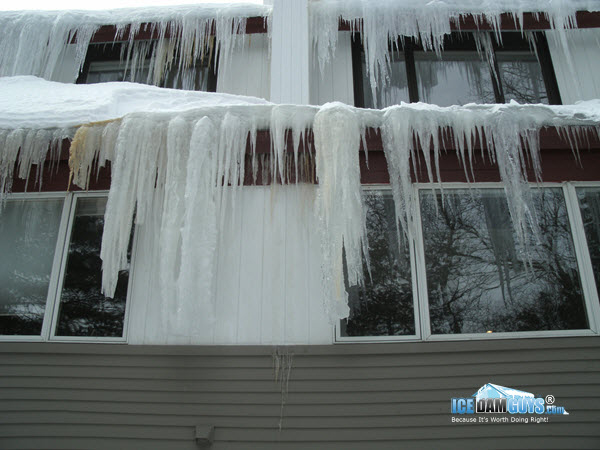
The density of the snow matters, too.
The next question to ask yourself is whether you’ve got light, fluffy, powdery snow, or wet, heavy snow. That heavy snow can weigh ten times or more what the powdery snow weighs. If the snow is particularly wet you might want to be proactive around the time you see 1-1.5 feet of snow, even if you have a pitched roof. It can’t hurt, and you’ll avoid the possibility of waking up one morning to find out it snowed again overnight and your roof couldn’t take any more.
Consider snow drifts.
Two feet of snow on a roof often is not two feet of neat, orderly snow that maintains an even depth across the roof. Some spots on your roof may hold a three- or four-foot snow drift. This is likely to happen any place where the roof meets an exterior wall, next to a dormer, or in any spot where the roof forms a valley (where two sloped roofs meet). Those places are under extra stress, so you may want to remove the snow from those areas sooner.
Are you supposed to get on you roof with a ruler and start measuring snow?
If you’re not good at eyeballing snow depth and you’ve missed the latest weather report, then you need some method of understanding when there’s just too much snow on your roof. Fortunately, there is a little trick you can use.
Go through your house open and close every door and every window.
If the doors and windows are easy to open, then you’re probably okay. But if even one of those doors and windows is suddenly unusually difficult to open, you may very well have a problem with excess snow load. The snow may be putting so much weight on your roof that it’s literally compressing your window or door openings. You’d better get the snow off your roof ASAP if that’s the case, no matter how much or how little you think is up there.
Mind you, I won’t claim that your roof will definitely collapse if that door or window won’t open. But that is a cause for concern, and I would err on the side of caution.
You can also call your roofer.
If you’re just not sure what kind of snow load your roof can take you can always call whomever installed the roof in the first place.
The Minnesota building code does include language on snow-load requirements. But they talk about it in terms of “pounds per square inch” or “pounds per square foot.” Most of us have no idea how to calculate that, so you should make sure your roofer talks in commonsense, non-jargon terms – like by telling you how many feet of snow your roof can withstand.
Of course, if you’ve got 3 feet of snow up there and he says, “Yeah, yeah, your roof can handle that,” be sure to get his first and last name – just in case he’s wrong.
For most people, ice dams are a bigger risk than roof collapses.
An ice dam only needs a tiny bit of snow to form on your roof. An ice dam can form with as little as an inch of snow (or even less). We’ve seen ice dams form when there’s no visible snow on any major part of the roof. Why? Because Old Man Winter loves to pile snow in the spots you can’t see from the ground – especially drifted snow in roof valleys and areas where your roof meets an exterior wall. Eventually those drifts can melt, trickle down, hit the overhangs and/or valleys, and slowly form an ice dam.
When should you remove snow if you’re worried about ice dams?
Well, in a perfect world, you’d get out there with your roof rake every time you get any snow at all. That’s not feasible for most people, though. Also, over-raking, like over-brushing your teeth, may actually do harm, in that you’ll rub many of the granules off your shingles. I’ve always used 6 inches as the rule of thumb: By the time you’ve got 6 inches of snow on your roof, it’s probably time to remove it if your goal is to avoid ice dams. Ideally all of it, but at least everything you can reach while standing safely on the ground with your roof rake.
Rake. Don’t shovel.
Do not try to shovel your own roof. It’s dangerous. We do it because we’re professionals and we’re properly insured to be out on cold, icy roofs in the dead of winter.
It’s also a question of the cost-effectiveness. If you had people like us shoveling your entire roof every time you saw six inches of snow, you’d spend more money on snow removal than you would on ice dam removal.
When you rake, reach as high as you can reach with your feet planted firmly on the ground. You’ll want to remove snow from the overhangs, at the very least. You should also try to get up into the valleys, as high as you can possibly reach. But don’t get a ladder. Do you really want to stand on a snowy, slippery ladder, in slippery boots, trying to pull snow toward you? What happens when a big chunk of snow spills off the roof towards you, or your rake handle potentially breaks free from the rake head? You’ll take a spill, and you’ll risk serious injury or death. It’s not worth it.
Snow removal does not prevent all ice dams.
That’s the bad news. In the world of ice dams there simply aren’t any guarantees.
Unfortunately, sometimes you can rake ten feet of snow off your roof and still get an ice dam right where you stopped raking (higher up on your roof). It does happen and it’s a shame when it does. However, it doesn’t happen the majority of the time, so don’t conclude that raking your roof is a waste of time. It’s a matter of probabilities. You are far less likely to get an ice dam if you rake your roof than if you don’t. I’d say 70% of the time you can prevent ice dams just by raking your roof.
Some people skip raking their roof because they’d rather the ice dam form low on their roof, where there’s some ice and water shield. They’d prefer that to raking their roof and risking the chance of an ice dam forming higher on their roof, where there probably isn’t any ice and water shield. The trouble with that logic is they’re simply increasing the likelihood that they get an ice dam. Whether or not it forms on the more-protected part of your roof, it’s still a hazard.
A build-up of ice along your overhang means you’re already looking at an ice dam. Now, it doesn’t much matter how much snow is on your roof. You need to get it off or your ice dam will continue to grow larger and become a greater hazard. You’ll want to call someone to remove all the snow and ice, or there’s a good chance the ice dam will cause a leak in your home. If removing all the snow and ice is simply cost prohibitive, then at the very least have all the ice removed and your overhangs and/or valleys cleared of snow.
Finally, make sure you look at the entire roof.
This piece of advice applies whether you are trying to prevent roof collapses or ice dams, or both. Many people only look at the part of their roof that they can see from their driveway as they leave or pull in. That’s their sniffer test. If the roof looks OK from that vantage point, they assume it’s OK.
If you really want to be safe, take the time to walk the perimeter of your home, just in case there’s an 8-foot snow drift that’s not visible from your driveway. Patrol that beat right after every major snowfall. It will be cold and it won’t be fun. But it won’t take you more than a few minutes, but I guarantee it will be far less painful than a roof collapse or an ice dam that causes thousands of dollars in damage to your home and your valuables.













